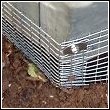Chickens & Chicken Coops
Protecting Chickens From Predators
Ned Bruha, President of The Wildlife Whisperer, Inc. claims his first "friends" were chickens. One of his first jobs was caring for the chickens, gathering eggs and one of his first wildlife control missions was keeping wild animals out of the chicken house and yard.
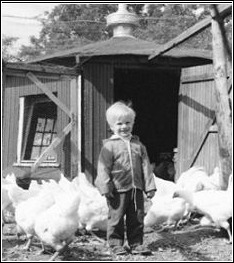
At a young age, his father taught him how to make underground barriers (known as a hardware cloth bury), to keep digging animals like badgers, skunks and coyotes out and a solid chicken house able to keep out mice and snakes. Little did he know that these experiences would assist others in the future or that he would someday invent a product to stop wildlife from digging into chicken enclosures (Dig Defence Animal Control).
Keeping Skunks, Raccoons, Snakes, Opossums, Foxes,
Weasels And Coyotes From Raiding The Chicken Coop
The number one way to prevent loss of your chickens, ducks, geese and guineas is to count them every evening and close the door with them all inside. Counting all of your birds at sundown will allow you to find that straggler hiding under a bush or sleeping around the corner. A large number of animals are lost because owners do not count their birds or close them up at night.
Below are some more methods of protecting your feathered friends.
Every year we receive countless calls in regards to wildlife getting into chicken houses to steal eggs and kill chickens. There are countless different ways to prevent these wildlife intruders. Typically the price to repeatedly trap and relocate chicken coop invading animals will far exceed the cost of reinforcing the chicken house and in most cases exceed the value of the chickens. Proper design and feeding habits can drastically reduce problems. The plain and simple truth is in the form of my favorite saying, "if you feed them, they will come."
The most common invaders of chicken coops are rats, black rat snakes, skunks, weasels, mice, mink, opossum, raccoon, and of course, coyotes and foxes. Owls also often will kill chickens.
Ideal Chicken Coop Design - Flooring & Foundation
Designing your chicken coop to be wildlife proof from the beginning is the most cost effective way to avoid problems, including egg and chicken loss. Of course it is always best to have a concrete floor in the chicken house to prevent skunks and other animals from digging under, but if this is not possible, you can prevent digging with the use of a hardware cloth bury or installing Dig Defense Animal Control Commercial Grade. These two underground barriers will pay for themselves overnight when a skunk or fox take advantage of that dirt bath your chickens made against the chicken coop wall and use it to dig in.
These barriers are very effective against digging animals.
Another way to protect a dirt floor of a chicken coop from digging animals is to install low voltage ribbon or wire several inches off the ground and a few inches off the wall of the chicken house. Although this will make skunks spray when they are "juiced", it will certainly train them as well as the neighbor's dog to not be chicken coop raiders.
Please note the photographs below.
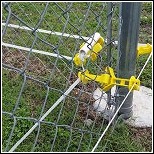
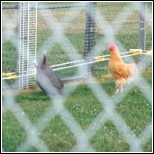
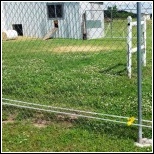
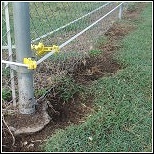
Proofing Chicken Coop Windows, Doors and Roofs
When building your chicken coop and choosing materials remember that rats can fit through anything the size of a quarter, mice can fit through anything the size of a pencil poke, skunks can walk right through chain link fence, and a opossum or raccoon can fit through holes between 2½ and 4½ inches. These animals may look large, but, when you have seen full grown raccoons fitting through a 4.5" hole and a full grown and pregnant opossum living and giving birth in a squirrel house with a hole cut with a 2.5" hole saw, you will never look at construction gaps and weak spots on homes or chicken houses the same again. Leaving a 4 inch hole to pour feed or water through the wall may sound like a good idea until a raccoon or snake utilizes the hole to obtain a midnight snack. Chicken wire should not even be used for chickens; it is very weak and allows snakes, rats, and any powerful animal such as a raccoon to go right through it. One quarter inch galvanized hardware cloth will be much more effective at keeping many species of wildlife out of your chicken coop.
Roofs, doors and your chicken entry door should be made rock solid with no gaps that are not heavily screened with ¼" hardware cloth or woven wire. Closing your chicken entry door each evening and latching it closed will pay for itself. If you utilized commercially available windows with screens in them, be certain to build an additional ¼" hardware cloth screen to go over the thin, stock window screening. A raccoon can sneeze on a stock screens and get your chickens.
Wildlife Proof Chicken Yards
Coyotes, foxes and your neighbor's dog can jump over a 4 foot fence. A 6 foot fence is necessary in order to keep most chicken killing animals out of a chicken yard. Additional protection around the entire yard to prevent wildlife from digging under is needed. Your chicken yard fencing or enclosure is your first line of defense. Low voltage lines at the bottom or Dig Defence will stop most if not all intruders.
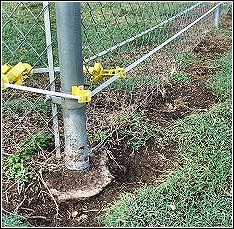
Note the above photo of a chicken dust bath being made right next to the chicken yard fence line. If the low voltage line was not there, that would be a quick entry point for a skunk, raccoon, fox or your neighbor's dog.
If you live in an area where you can have a guard donkey or other guard animal, like the one below, they will show you a return on investment by keeping unwanted chicken killing animals out of the pasture.
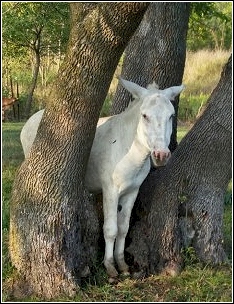
Hawks & Owls
Chickens are often times stolen in the middle of the night or broad daylight by hawks, owls and other raptors. If you have free range chickens and they are not in your yard, there is not a whole lot of chance for protection or prevention. If your yard is small enough to be covered by heavy screening or netting, doing so can save many if not all of your birds.
Owls stealing chickens in the middle of the night or daytime can be prevented with the use of ultra sonic noise emitting units called Yard Guard’s. Owls hate ultra sonic sounds and it will drive them away.
The Wildlife Whisperer, Inc. has tested ultrasonics in many different situations and has accidentally found that owls detest ultra sonic sounds. Having a Yard Gard unit or multiple units around the chicken house aimed in a manner to not allow any obstructions in front of them is a good investment.
Chicken Tractors
Chicken tractors (mobile chicken houses that get moved around on wheels) must be constructed in a very solid manner with small mesh and sturdy frame work in order to keep animals out. The only way to prevent skunks and other animals from digging under a tractor is to install a low voltage line around the bottom portion of the coop and powering it with solar or an extension cord. Installing dig proof underground barriers to a chicken tractor defeats the purpose of a mobile chicken house.
Feeding Chickens
Not only are chickens attractive to wildlife and your neighbors dog, but the chicken feed is also attractive to rodents. Rodents are irresistible to snakes, and snakes are also very fond of chicken eggs. This is why some people call black rat snakes, chicken snakes.
If you have chickens or guineas who lay clutches of eggs in various areas, it is important to discourage "stray eggs", like those pictured below, by supplying more attractive laying boxes because stray eggs will certainly attract snakes, skunks and other chicken egg eating wild animals.
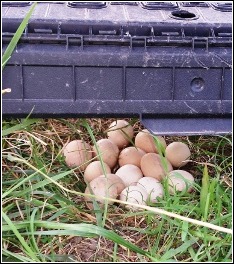
Having chickens on a "free food diet"by utilizing gravity feeders that continually supply chicken feed will almost certainly allow for waste. If rats and mice can access the feeder itself, you can imagine how that smorgasbord of feed will allow them to breed out of control. Generally speaking, when chickens have constant access to feed they appreciate it less and all of the food that falls on the ground goes to waste. Although gravity feeders are convenient, the mouse and rat problem that comes along with them is not appealing. Feeding your chickens directly on the ground with a set amount of feed that they can consume without waste will drastically decrease rodent activity.
Having a barn cat to remedy your mouse and problem is sometimes a good solution. If you need barn cats, contact The Wildlife Whisperer office, as they are in contact with programs that can supply you with hard working mouse and rat catchers for little to no money. The fact is, if you have chickens and/or hay, you will have rodent issues at some point.
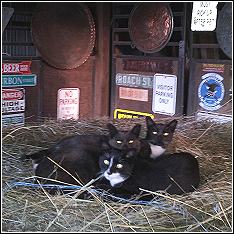
Conclusion
In conclusion, spending several hundred dollars to trap a chicken house raiding animal is too expensive in the mind of most callers to our company. People who call complaining about chicken and wildlife problems are encouraged to follow the above methods or hire us to implement them. If you have a small or gigantic chicken house or if you are just in the design phases, we can certainly assist you with building or altering a chicken house to be wildlife proof.
1242 SW Pine Island Rd., Suite 310
Cape Coral, Florida 33991-2126
help@totalwildlifecontrol.com



